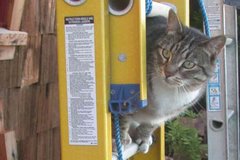fault the bounds the southwest boundary of the Viscaino block,
collecting multibeam data to get good bathymetry. we want to try to
work out the geometry to see if it is synistral or dextral strike slip
or thrust (if we can). in some places it looks right lateral, some
places left lateral. once we look at the mapped data, in its entirety,
we may have a better idea.
then we collected a kasten core (8" square core, 10' long) and a box
core (24" square, 18" deep) at a previous site (where core 16JC is
located, a core with a great record of nice and sandy turbidites).
we are on a transit currently to head for some channel systems along
the northern part of the Viscaino block, we are now calling this the
northern Viscaino channel (perhaps we could be a little more creative,
hahaha). in 1999, Goldfinger collected a core in this area, but never
did anything with the core. while on this cruise, he looked at the
high resolution magnetic data and it indeed looks like a promising
site. basically, the northern cores (south of Cape Mendocino) have
large SAF turbidites underlain by small CSZ turbidites. the further
south, the smaller the CSZ turbs get. The northern Viscaino channel
has the potential to have the largest CSZ turbs as the most upper
canyons are on the southern flank of the Mendocino fault (most
proximal to the CSZ of all other canyon systems). Secondly, this
channel system is not connected to terrestrial input.
tempers continue to be short as the cruise wears on everyone. nobody
seems to be immune, including yours truly. (there are some who do
appear to be immune, perhaps some correlation with the amount of
responsibility)
the 3.5 kHz echosounder sub-bottom profiler has been giving us grief
the entire cruise. we finally (yesterday) switched to the back up
control box and it seems to be working now. we should have done this
earlier (but there is always a tradeoff between stopping getting data
for a while during the switchover).
peace out, jay


No comments:
Post a Comment